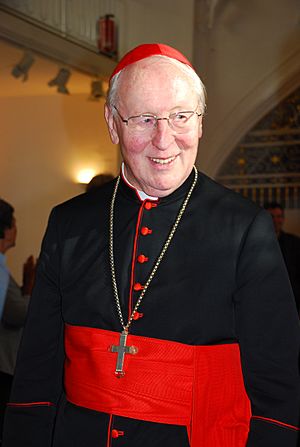Friedrich Wetter facts for kids
Quick facts for kids His Eminence Friedrich Wetter |
|
|---|---|
| Cardinal, Archbishop Emeritus of Munich and Freising |
|
 |
|
| Church | Catholic Church |
| Archdiocese | Munich and Freising |
| See | Munich and Freising |
| Appointed | 28 October 1982 |
| Enthroned | 12 December 1982 |
| Reign ended | 2 February 2007 |
| Predecessor | Joseph Ratzinger |
| Successor | Reinhard Marx |
| Other posts | Cardinal Priest of Santo Stephano in Coelio Monte (1985–) |
| Orders | |
| Ordination | 10 October 1953 |
| Consecration | 29 June 1968 by Isidor Markus Emanuel |
| Created Cardinal | 25 May 1985 |
| Rank | Cardinal-Priest |
| Personal details | |
| Born | 20 February 1928 Landau, Germany |
| Denomination | Catholic |
| Previous post |
|
| Alma mater |
|
| Motto | Pax Vobis ("Peace to you") |
| Coat of arms |  |
| Styles of Friedrich Wetter |
|
|---|---|
 |
|
| Reference style | His Eminence |
| Spoken style | Your Eminence |
| Informal style | Cardinal |
| See | Munich and Freising (emeritus) |
Friedrich Wetter (born 20 February 1928) is a German cardinal of the Catholic Church. He was Archbishop of Munich and Freising, Germany, from 1982 to 2007. He was Bishop of Speyer from 1968 to 1982. He has been a cardinal since 1985.
Early life
Wetter was born on 20 February 1928. He studied first in Landau and then from 1948 to 1956 at the Sankt Georgen Graduate School of Philosophy and Theology and at the Gregorian University in Rome, where he obtained a doctorate in theology. In 1953, he was ordained a priest in Rome by Cardinal Cardinal Clemente Micara.
He was a chaplain in Speyer from 1956 to 1958 and taught at the seminary there from 1958 to 1960. He was assistant parish priest for a year in Glanmünchweiler, and then taught as Professor of Fundamental Theology in Eichstätt from 1962 to 1967 and as Professor of Dogmatic Theology at the Johannes Gutenberg University of Mainz in 1967 for a year.
Bishop and cardinal
On 28 May 1968, Pope Paul VI appointed him bishop of Speyer. He received his episcopal consecration on 29 June from Bishop Isidor Markus Emanuel, his predecessor in Speyer.
Pope John Paul II named him Archbishop of Munich and Freising on 28 October 1982 and he was installed there on 12 December.
While Archbishop of Munich and Freising, he chaired the Freising Bishops Conference and from 1981 to 2008 he chaired the faith commission of the German Bishops' Conference.
He was made a cardinal by Pope John Paul on 25 May 1985, with the title of Cardinal-Priest of Santo Stefano Rotondo.
In October 2004 he protested that objections to the appointment of Rocco Buttiglione to the European Commission represented anti-Catholic bias, saying that Catholics like Konrad Adenauer, Robert Schuman, and Alcide de Gasperi, founders of the European Union, would now be excluded from its leadership. Buttiglione, a conservative Catholic nominated to handle issues of civil liberties and discrimination, had promised that his personal views would not interfere with his work, but members of the European parliament found his views on homosexuality and the proper role of women in society disqualifying.
He was one of the cardinal electors who participated in the 2005 papal conclave that elected Pope Benedict XVI.
Pope Benedict accepted his resignation on 2 February 2007. He continued there as apostolic administrator until the installation of Reinhard Marx as his successor on 2 February 2008.
..... Wetter defended his actions in detail and disputed much of the report; he admitted fault in one case in particular that the report addressed at great length. He apologized for failing to listen to victims of abuse and recognizing how abuse affected them and their families.
Works (selected)
- Die Trinitätslehre des Johannes Duns Scotus (= Beiträge zur Geschichte der Philosophie und Theologie des Mittelalters, file 41, H. 5), Aschendorff, Münster 1967, (Thesis of Habilitation, University of Munich, Munich, Theological Faculty, 28. Oktober 1965).
See also
 In Spanish: Friedrich Wetter para niños
In Spanish: Friedrich Wetter para niños
- Cardinals created by John Paul II

